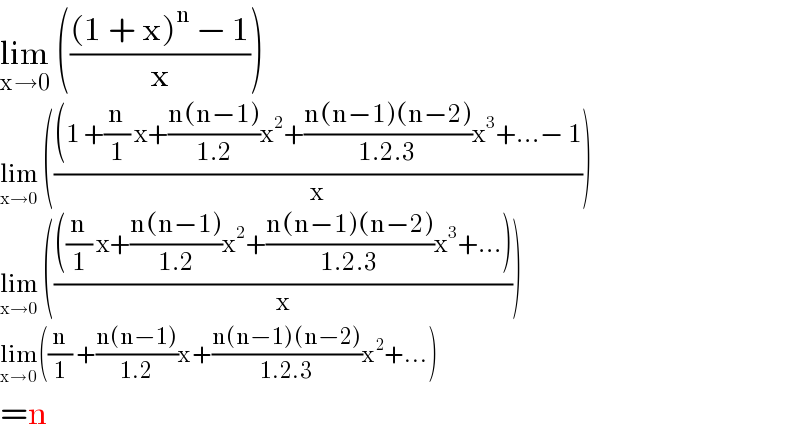
Question Number 25379 by A1B1C1D1 last updated on 09/Dec/17

$$\underset{\mathrm{x}\:\rightarrow\:\mathrm{0}} {\mathrm{lim}}\:\left(\frac{\left(\mathrm{1}\:+\:\mathrm{x}\right)^{\mathrm{a}} \:−\:\mathrm{1}}{\mathrm{x}}\right)\:\mathrm{for}\:\mathrm{a}\:\in\:\mathbb{R} \\ $$$$ \\ $$$$\mathrm{Don}'\mathrm{t}\:\mathrm{using}\:\mathrm{L}'\mathrm{hospital}\:\mathrm{rules}. \\ $$
Answered by Rasheed.Sindhi last updated on 10/Dec/17

$$\underset{\mathrm{x}\rightarrow\mathrm{0}} {\mathrm{lim}}\:\left(\frac{\left(\mathrm{1}\:+\:\mathrm{x}\right)^{\mathrm{n}} \:−\:\mathrm{1}}{\mathrm{x}}\right) \\ $$$$\underset{\mathrm{x}\rightarrow\mathrm{0}} {\mathrm{lim}}\:\left(\frac{\left(\mathrm{1}\:+\frac{\mathrm{n}}{\mathrm{1}}\:\mathrm{x}+\frac{\mathrm{n}\left(\mathrm{n}−\mathrm{1}\right)}{\mathrm{1}.\mathrm{2}}\mathrm{x}^{\mathrm{2}} +\frac{\mathrm{n}\left(\mathrm{n}−\mathrm{1}\right)\left(\mathrm{n}−\mathrm{2}\right)}{\mathrm{1}.\mathrm{2}.\mathrm{3}}\mathrm{x}^{\mathrm{3}} +...−\:\mathrm{1}\right.}{\mathrm{x}}\right) \\ $$$$\underset{\mathrm{x}\rightarrow\mathrm{0}} {\mathrm{lim}}\:\left(\frac{\left(\frac{\mathrm{n}}{\mathrm{1}}\:\mathrm{x}+\frac{\mathrm{n}\left(\mathrm{n}−\mathrm{1}\right)}{\mathrm{1}.\mathrm{2}}\mathrm{x}^{\mathrm{2}} +\frac{\mathrm{n}\left(\mathrm{n}−\mathrm{1}\right)\left(\mathrm{n}−\mathrm{2}\right)}{\mathrm{1}.\mathrm{2}.\mathrm{3}}\mathrm{x}^{\mathrm{3}} +...\right)}{\mathrm{x}}\right) \\ $$$$\underset{\mathrm{x}\rightarrow\mathrm{0}} {\mathrm{lim}}\left(\frac{\mathrm{n}}{\mathrm{1}}\:+\frac{\mathrm{n}\left(\mathrm{n}−\mathrm{1}\right)}{\mathrm{1}.\mathrm{2}}\mathrm{x}+\frac{\mathrm{n}\left(\mathrm{n}−\mathrm{1}\right)\left(\mathrm{n}−\mathrm{2}\right)}{\mathrm{1}.\mathrm{2}.\mathrm{3}}\mathrm{x}^{\mathrm{2}} +...\right) \\ $$$$=\mathrm{n} \\ $$
Commented by A1B1C1D1 last updated on 09/Dec/17

$$\mathrm{Thank}\:\mathrm{you} \\ $$
Answered by moxhix last updated on 10/Dec/17

$${another}\:{way} \\ $$$${put}\:{f}\left({x}\right)=\left(\mathrm{1}+{x}\right)^{{a}} \\ $$$${f}\:'\left({x}\right)={a}\left(\mathrm{1}+{x}\right)^{{a}−\mathrm{1}} \rightarrow{f}\:'\left(\mathrm{0}\right)={a} \\ $$$${f}\:'\left(\mathrm{0}\right)=\underset{{x}\rightarrow\mathrm{0}} {{lim}}\frac{\left(\mathrm{1}+{x}\right)^{{a}} −\left(\mathrm{1}+\mathrm{0}\right)^{{a}} }{{x}−\mathrm{0}} \\ $$$$\therefore\underset{{x}\rightarrow\mathrm{0}} {{lim}}\frac{\left(\mathrm{1}+{x}\right)^{{a}} −\mathrm{1}}{{x}}={a} \\ $$
